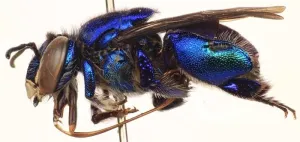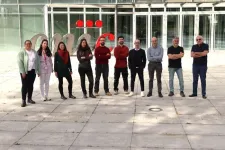(Press-News.org) COLUMBUS, Ohio – Some Black youth feel less safe when they visit predominantly white areas of their city, a new study in Columbus has found.
And it was those Black kids who spent the most time in white-dominated areas who felt less safe, said Christopher Browning, lead author of the study and professor of sociology at The Ohio State University.
“Familiarity with white neighborhoods doesn’t make Black kids feel more comfortable and safer. In fact, familiarity seems to reveal threats,” Browning said.
“It is not a terribly optimistic finding.”
The study was published online recently in the Journal of Adolescent Health.
The study is one of the first to examine racial differences in how urban youth perceive their safety in real time, Browning said. Data came from the federally funded Adolescent Health and Development in Context study, which involved 1,405 11- to 17-year-old youths in Columbus.
Researchers gave participants smartphones, which they used to report on how safe they felt as they moved through the city over a one-week period.
Five random times a day, the youths received a mini-survey that asked them where they were, what they were doing, who they were with and social characteristics of the setting. The GPS on their phone also recorded their location.
Each survey also asked them to rate on a 5-point scale if the location they were in was a safe place to be.
Researchers classified the youth as being in a white-dominated area if the census-block they were in when they were surveyed was at least 70% non-Hispanic white.
The study also measured violent crime levels in the areas that the youth visited.
Results showed that youth generally felt safe when they were near their homes – those who were within 30 meters of their home had about a 14% greater probability than others of strongly agreeing they felt safe in the moment.
Not surprisingly, both Black and white youth were less likely to say they felt safe when they were in census blocks that had higher violent crime rates.
But it was the racial differences that were of greatest interest to the researchers.
“When white youth are in white-dominated spaces, they tended to feel a little safer,” said Browning, who is also a member of Ohio State’s Institute for Population Research. “But that’s not the case for Black youth.”
The issue that Black youth face in Columbus and most other cities is that the resources they want and need – such as shopping, entertainment, libraries and restaurants – are often located in predominantly white areas.
Results of the study showed that Black youth who live in segregated, predominantly Black neighborhoods spend an average of 40% of their non-home time in white-dominated neighborhoods – about twice as much time as they spend in their own neighborhoods.
And the unsafe feeling for Black participants in the study increased with more exposure to predominantly white neighborhoods. For example, for teenagers exposed, on average, to 70% white neighborhoods, being outdoors in a white neighborhood reduced the probability of reporting strong agreement that the location was safe by about 26%.
“There is this complicated trade-off that Black youth have to navigate in which they want to take advantage of these organizational resources that are mainly available in white areas of the city,” Browning said. “But they also have to deal with feeling concerned about their safety.”
In order to keep the mini-surveys short, youth were not asked what led to their feelings of relative safety when they were in different parts of the city. But other research points to why Black youth would feel less safe in white-dominated areas of the city, he noted.
There is the fear of being the victim of racial violence or having a potentially dangerous encounter with police, which, while rare, is always possible, he said.
“But there is also the sense of psychological safety. We think of it as the sense of trust that Black youth have that they can be themselves and not be at risk of being excluded, which could include anything from microaggressions to outright discrimination,” he said.
This perception of being less safe in white neighborhoods may have real-life health consequences for Black youth. In a study published last year in the journal Psychoneuroendocrinology, Browning and colleagues measured hair cortisol concentrations in some of the same Black and white youths (690 total) involved in this research. High hair cortisol levels indicate elevated levels of chronic stress.
The findings showed that Black youth who perceived they were less safe also had higher levels of hair cortisol. Similar findings were not seen in white kids.
“We found that feelings of safety among Black kids predict this biological indicator of stress found in hair. High levels of chronic stress could have negative effects on health,” Browning said.
The results show the challenges that Black youth face living in American cities.
While a lot of attention has been paid to the problems Black youth face growing up in segregated neighborhoods, this study suggests that leaving those areas may present problems as well.
“Black youth face unique challenges when they try to use the resources that are often found only in white-dominated neighborhoods in their city,” Browning said.
Other co-authors were Bethany Boettner of Ohio State’s IPR; Nicolo Pinchak of the University of Oxford in the UK; and Catherin Calder of the University of Texas at Austin.
Funders of the study included the National Institute on Drug Abuse, the Eunice Kennedy Shriver National Institute on Child Health and Human Development, and the W.T. Grant Foundation.
END
Visiting white parts of town make some Black kids feel less safe
Familiarity seems to reveal threats, new study finds
2024-04-10
ELSE PRESS RELEASES FROM THIS DATE:
Deforestation harms biodiversity of the Amazon’s perfume-loving orchid bees
2024-04-10
LAWRENCE — A survey of orchid bees in the Brazilian Amazon state of Rondônia, carried out in the 1990s, is shedding new light the impact of deforestation on the scent-collecting pollinators, which some view as bellwethers of biodiversity in the neotropics.
The findings, from a researcher at the University of Kansas, are published today in the peer-reviewed journal Biological Conservation.
“This study on orchid bees was an add-on to previous research on stingless bees. Orchid bees are so easy to collect, so we added them to ...
Long-term satellite observations show climatological characteristics of isolated deep convection over the Tibetan Plateau
2024-04-10
The Tibetan Plateau is a prevalent region for deep convection owing to its unique thermodynamic forcing. Deep convection can exist as isolated deep convection (IDC), which is small in size, or mesoscale convective systems (MCSs), which are convective storms organized into larger and longer-lived systems. Most previous research has focused on MCSs over the Tibetan Plateau, but less so on IDC systems (hereafter, IDCs).
Dr. Ying Na from Wuxi University, and Dr. Chaofan Li from the Institute of Atmospheric Physics, Chinese Academy of Sciences, China, examined the climatological features of IDCs by using high-resolution satellite observations in June to September ...
Modeling viral evolution: A novel SIRSVIDE framework with application to SARS-CoV-2 dynamics
2024-04-10
Understanding the mutation and evolution of viruses (such as SARS-CoV-2) is crucial for effective public health management and response. Traditional epidemiological models often assume that viral transmissibility and pathogenicity remain constant during disease transmission, ignoring the fact that viruses continuously evolve through natural selection and random mutations. This simplification limits the accuracy of these models in predicting epidemic trends, especially when facing rapidly mutating viruses.
To overcome these limitations, ...
New data: UTSA economic development institute added $2.6 billion to Texas’ economy
2024-04-10
SAN ANTONIO, TEXAS — The Valdez Institute for Economic Development (VIED) at UTSA generated an overall direct economic impact of $2.6 billion for the Texas economy in 2023, according to the organization’s 2023 annual report, which was released Tuesday.
The latest figure represents the work of the institute’s portfolio of time-tested economic development strategies and new innovations that enabled business owners and entrepreneurs to start and grow their small businesses.
During the 2023 fiscal year, the institute:
Served 41,231 business ...
Waterproof ‘e-glove’ could help scuba divers communicate
2024-04-10
When scuba divers need to say “I’m okay” or “Shark!” to their dive partners, they use hand signals to communicate visually. But sometimes these movements are difficult to see. Now, researchers reporting in ACS Nano have constructed a waterproof “e-glove” that wirelessly transmits hand gestures made underwater to a computer that translates them into messages. The new technology could someday help divers communicate better with each other and with boat crews on the surface.
E-gloves — gloves fitted ...
BioOne presents 2024 BioOne Ambassador Award to five early career scientists
2024-04-10
BioOne proudly announces the 2024 recipients of the BioOne Ambassador Award. Now in its seventh year, this prestigious award recognizes early-career researchers in the biological, ecological, and environmental sciences who demonstrate creative approaches to science communication thereby fostering greater science literacy and aiding in the understanding of the natural world. BioOne Ambassadors are nominated by BioOne publishing partners, and each winning author will receive a $1,000 award and have their work promoted through BioOne’s multiple channels.
This year’s honorees are:
Dr. Elis Fisk – Draw and Learn: A Bighorn Sheep Mystery; nominated by The Wildlife ...
Thinking outside the doctor’s office: Poll looks at older adults’ use of urgent care, retail clinics and more
2024-04-10
When today’s older adults were growing up, urgent care centers and clinics inside retail stores didn’t exist. But most of them have now embraced these non-traditional sites for getting medical care, a new national poll finds.
In the past two years, 60% of people age 50 to 80 have visited an urgent care clinic, or a clinic based in a retail store, workplace or vehicle, according to new findings from the University of Michigan National Poll on Healthy Aging.
Urgent care clinics were the most ...
New mechanism discovered for the life-threatening arrhythmias in Andersen-Tawil syndrome
2024-04-10
A team at the Centro Nacional de Investigaciones Cardiovasculares (CNIC) has made a breakthrough discovery in the understanding of cardiac arrhythmias by unraveling the complexities of Andersen-Tawil syndrome (ATS), an extremely rare inherited cardiac disorder. Led by Dr. José Jalife, head of the CNIC Cardiac Arrhythmia Group, the study demonstrates that a specific genetic mutation (C122Y) in the Kir2.1 potassium channel alters the function not only of Kir2.1 but also of the main cardiac sodium channel NaV1.5, thus establishing a direct link with the life-threatening arrhythmias associated with ATS1.
The study, published in the journal Circulation Research, reveals that ...
Study suggests racial discrimination during midlife associated with Alzheimer’s disease pathology later in life
2024-04-10
WINSTON-SALEM, N.C. – April 10, 2024 – Racial discrimination experienced during midlife is associated with Alzheimer’s disease pathology, according to a new study from researchers at Wake Forest University School of Medicine and the University of Georgia.
The findings appear online today in Alzheimer’s & Dementia: The Journal of the Alzheimer’s Association.
“We know that Black Americans are at an elevated risk of Alzheimer’s disease and other dementias compared to non-Hispanic ...
The future of xenotransplantation is nearly here
2024-04-10
Embargoed until 10:30 a.m. Wednesday, 10 April, 2024 Central European Summer Time (GMT +2)
10 April, 2024, Prague, Czech Republic—Speaking today at the Annual Meeting and Scientific Sessions of the International Society for Heart and Lung Transplantation (ISHLT) in Prague, Muhammad Mohiuddin, MBBS, said xenotransplantation, hailed as the future of organ transplantation, is poised to become a clinical reality within the next several years.
In January 2022, the University of Maryland School of Medicine (UMSOM) became the first institution in the world to implant a genetically modified pig heart ...
LAST 30 PRESS RELEASES:
Heart-brain connection: international study reveals the role of the vagus nerve in keeping the heart young
Researchers identify Rb1 as a predictive biomarker for a new therapeutic strategy in some breast cancers
Survey reveals ethical gaps slowing AI adoption in pediatric surgery
Stimulant ADHD medications work differently than thought
AI overestimates how smart people are, according to HSE economists
HSE researchers create genome-wide map of quadruplexes
Scientists boost cell "powerhouses" to burn more calories
Automatic label checking: The missing step in making reliable medical AI
Low daily alcohol intake linked to 50% heightened mouth cancer risk in India
American Meteorological Society announces Rick Spinrad as 2026 President-Elect
Biomass-based carbon capture spotlighted in newly released global climate webinar recording
Illuminating invisible nano pollutants: advanced bioimaging tracks the full journey of emerging nanoscale contaminants in living systems
How does age affect recovery from spinal cord injury?
Novel AI tool offers prognosis for patients with head and neck cancer
Fathers’ microplastic exposure tied to their children’s metabolic problems
Research validates laboratory model for studying high-grade serous ovarian cancer
SIR 2026 delivers transformative breakthroughs in minimally invasive medicine to improve patient care
Stem Cell Reports most downloaded papers of 2025 highlight the breadth and impact of stem cell research
Oxford-led study estimates NHS spends around 3% of its primary and secondary care budget on the health impacts of heat and cold in England
A researcher’s long quest leads to a smart composite breakthrough
Urban wild bees act as “microbial sensors” of city health.
New study finds where you live affects recovery after a hip fracture
Forecasting the impact of fully automated vehicle adoption on US road traffic injuries
Alcohol-related hospitalizations from 2016 to 2022
Semaglutide and hospitalizations in patients with obesity and established cardiovascular disease
Researchers ‘listen in’ to embryo-mother interactions during implantation using a culture system replicating the womb lining
How changing your diet could help save the world
How to make AI truly scalable and reliable for real-time traffic assignment?
Beyond fragmented markets: A new framework for efficient and stable ride-pooling
Can shape priors make road perception more reliable for autonomous driving?
[Press-News.org] Visiting white parts of town make some Black kids feel less safeFamiliarity seems to reveal threats, new study finds






